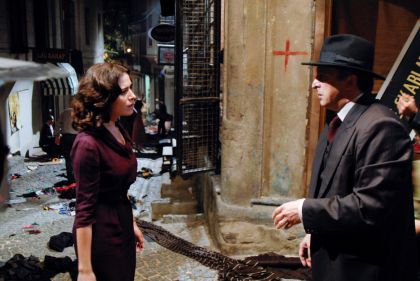The Turkish public, at least a part of it, had to wait for 50 years to learn what really happened during the pogrom against the Christian inhabitants of Istanbul in September 1955. In 2005 Dilek Guven’s very detailed doctorate thesis on the Septembriana presented at the Bochum University in Germany was published in Turkish. Same year, photographs and documents compiled by the martial law judge retired Admiral Fahri Coker (Tsoker) who served at the court that tried the suspects was also printed and distributed.
Tomris Giritlioglu’s film “The Autumn Pain” comes four years later as a cinematographic account of a love affair between a Greek girl from Istanbul and a Turkish boy who comes from a staunchly rightwing and chauvinist but at the same time rich family with a backdrop of Septemvriana.
The scenario is based on a novel by Yilmaz Karakoyunlu, a former parliamentarian who has also written an earlier novel about the Wealth Tax levied on Turkey’s non-moslems in 1942. That novel was also put on film by Giritlioglu with the title “Mrs. Salkim’s Diamonds.”
As “Mrs. Salkim’s Diamonds” then, “The Autumn Pain” is also hailed now by most of the commentators as an artistic attempt to recognize the injustices done to Turkey’s non-moslem minorities.
“The Autumn Pain” completes Giritlioglu’s trilogy which started with “The Other Side of the Water” that again told us a love story between a Greek girl and a Turkish boy as the tragic events of exchange of populations in 1922 between Turkey and Greece unraveled.
Ali Acikoz (Atcikoz), one of the commentators on “The Autumn Pain,” points out to the most likely pitfalls in film scenarios structured as a love story at times of social or political turmoil. “Since our generation has witnessed all these events, I did not find any difficulty in understanding the movie. But I looked at the faces of young people as they left the cinema. They were perplexed. They watched a sad love story taking place with a background of some horrible violence. But who did it and why it was done were questions still bothering them as they left the movie house,” he wrote.
Of course, “The Autumn Pain” is not a documentary. But even as feature film it should not have done injustice to the subject.
Until Dilek Guven’s book was published and Admiral Tsoker’s documents and photographs were printed, the general impression in Turkey was that the Septemvriana was organized by the government of Adnan Menderes in 1955 to put pressure on Greece and Greek Cypriots while the then Foreign Minister Fatin Rustu Zorlu was in London negotiating the future of Cyprus. The simple explanation for the pogrom was that the crowds went out of control and did what they did. Guven, in her book, mentions a note sent by a member of the British Embassy in Athens then, saying “A little harassment of the Greek population in Istanbul would help.” At that time the British were supporting the Turkish theses on Cyprus.
But there was more to that. In 2001 journalist Fatih Gullapoglu, interviewed retired General Sabri Yirmibesoglu, the former head of Turkish army’s Department of Special Warfare, who admitted that it was his organization that mobilized the Turkish Cypriots against Greek Cypriots. He also declared that Septemvriana was also one of the “perfect jobs done by the Special Warfare Department.” It seems that it was one of the major operations to dispossess the non-Moslem minority and force them to leave Turkey, a well known policy of the Turkish governments since the 19’/20s, as the case was in the Wealth Tax of 1942.
Naturally, it would not be just to expect Giritlioglu’s movie to explain all these historical facts. It is just a feature film. However, there are also criticisms leveled against the film in terms of cinematography. Most of the actors have been selected from television serials and their performance weighs towards that category of acting. Also, most of the critics found the scenes illustrating the ravage on Istanbul streets during 6-7 September 1955 “not realistic enough.”
Giritlioglu, herself admits that there are shortcomings in the movie. In an interview she gave, she said, “We have put so much work into the film. Still I find a lot of faults in myself. For example we had to edit the final scene which was an enacting (of riots) as we shot it. I say to myself when I watch those scenes, we should have gone over them again and again. I wish we had more time for editing and post production.” Despite all criticism, “The Autumn Pain” is a movie for Turks to come to grips with their recent past.
A final comment came from a Jewish friend of mine married to a Turkish man who said, “Why should Elena, the Greek girl, be portrayed as an innocent whore?” Well, certainly Giritlioglu should not be blamed for that. The guilt belongs to the novelist, Karakoyunlu.




